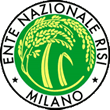ORIGINS AND GROWING
Rice is one of five species basic food for mankind and is the main crop on earth. Belongs to the Gramineae, the family of Monocotyledons, and is called Oryza Sativa. Based on the characters and the genetic origins, Sativa Oryza is divided into: more rounded grains and more elongated grain.
The thermal blanket
The Oryza Sativa is grown in Asia, America, Africa, Europe and Australia. It is a tropical plant that requires temperature and humidity adequate. Appropriately adattatasi over the centuries for European climates, however, must be protected with a layer of water, a "water pool" that defends it from extreme temperature changes between day and night.
In Italy (and Europe where it is present in the Soviet Union, Spain, Portugal, Greece, France, Yugoslavia, Hungary, Romania) can not do without water in which the seedling grows from spring to late summer, with a growing period between 150 and 180 days. For the flowering requires a temperature around 30 degrees and it is estimated that to obtain one kilogram of rice should be used between 3,000 and 10,000 liters of water.
The cultivation
Stages of cultivation are basically four: tillage, seeding and flooding of the plots, elimination of weeds; harvest.
Operations, once handled by thousands of workers in Italy are now fully mechanized. The change has occurred in paddy field beginning in the late fifties when machines, fertilizers, seiettivi formulated to eliminate the weeds have reached a satisfactory degree of perfection.
One of the most beautiful in the cultivation of rice, is certainly the spring flooding of land, obtained with a complex system of channels. The rice field is transformed into an artificial lagoon as far as the eye will pass within a few weeks from silver to green crayon effect of young seedlings gradually emerging from the water. But the collection is equally fascinating. The harvesters, who cut fast and separate it from the rice straw, concentrate on large surfaces quickly a large amount of work.
When the corn is started with trailers from farm businesses, has a humidity of between 20 and 30%. The raw rice, or paddy rice, it is therefore placed in the drying plants in such a way that the moisture to drop to 14-15 ° and that does not lead to degradation processes.
The grain
The newly harvested rice grain is covered by an envelope with several layers, tending to brown or yellow and contains many substances.
Under the various protective layers, or integument, that taper from outside to inside, is the caryopsis. Each grain is also the bearer of an embryo, placed in a small sac, called spermoderma and that is essential for the perpetuation of the species.
The grain is made up of proteins and, in the innermost zone, of the starch granules of small size and angular, compact and gathered in bunches.
Rice is classified in the groups of all commodities common varieties, semithin, fine and superfine. The attribution of the varieties grown and marketed in each group, depending on the length and thickness of the grain, the appearance of the grain from its behavior during cooking. The municipalities have a length less than 5.4 mm.; The semithin are between 5.4 and 6.4 mm long.; Purpose and superfine measure more than 6.4 mm. Certain varieties needles produced in the East are even longer.
The transformation
The transformation of raw rice in edible rice is completely mechanical, so it can be introduced to his injury processes of sophistication.
Yesterday and today the principle used for processing rice, is the "husking".
The raw rice was once placed in a mortar battery also said. A pestle with a metal tip, rhythmically driven manually acted on grain and freed him from the outer layers containing fats and proteins. He was also the embryo or gem, rich in oil. Since the operation inevitably broke a percentage of grains, it was necessary to proceed with the disposal of the latter along with other impurities using separators such oscillating sieves, with ropes hanging from the soffttto.
The industrial structure of today's fully automated, following a precise pattern of working. Rice, cleansed of any foreign matter and, with the sbramino or debarking, by covering more esierno, passed in a first sbiancafrice: leave the pericarp and the embryo. It was at this point the husked rice, or brown rice, rich in fiber, and fatty parts, and therefore suitable for special diets.
A second whitening gives the semi-refined rice or cargo rice while the refined and obtained with a third whitening.
The stage of refining increases still going through the corn in a fourth whitening.
The nutritive properties
Each kilogram of paddy gives worked 6 hundred grams of edible rice. The transformation byproducts used in the feed, or in refractory and cosmetic industries. The main ones are broken, the granaverde, the gem, the flour, the husk.
By varying the level of refinement, varying the quantities of substances characteristic of rice, some of which are in the outer zone of the grain. The semi-refined rice or white rice with the merchant and the third whitening, are considered the most reliable in terms of digestibility and nutrition. Indeed ensure the right fit in proteins such as lysine and tryptophan methionine, essential for growth, the Group B vitamins, and vitamins PP, K and E, essential salts such as Potassium, Calcium, Phosphorus.
The rice proteins are superior in quality than any other cereal. Contain all 18 amino acids from which depends the regular human metabolism and are the absolute digestibility.
The main constituents of rice
|
Proteins Fats Carbohydrates |
gr. gr. gr. |
7-10 0,6 78,82 |
|---|---|---|
| Sodium Potassium Calcioum Phosphorus Iron |
mgr. mgr. mgr. mgr. mgr. |
6 80 8 120 0,6 |
| Thiamine Riboflavin Nicotinic Acid |
mgr. mgr. mgr. |
0,006 0,003 1,65 |

